Are you fascinated by the exotic allure of a caracal and wondering, Can You Keep A Caracal As A Pet? At PETS.EDU.VN, we understand the appeal of these magnificent creatures, often called desert lynx, but it’s essential to understand the unique challenges and responsibilities that come with owning a wild cat. While the idea may be tempting, it’s crucial to weigh the reality against the romanticized image. Delve into the world of caracal care, exotic animal ownership, and wildlife conservation with us.
1. Understanding the Caracal: A Wild Cat’s Profile
The caracal, scientifically known as Caracal caracal, is a captivating wild cat species native to Africa, the Middle East, Central Asia, and India. Despite its occasional nickname, “desert lynx,” it is not a true lynx, but rather a distinct species with unique characteristics. These felines have three subspecies: Southern caracal (C. c. caracal), Northern caracal (C. c. nubicus), and Asiatic caracal (C. c. schmitzi).
1.1. Physical Attributes and Natural Habitat
Caracals are characterized by their long legs, short, tan or sandy-colored coats, and distinctively large, tufted ears. These black ear tufts add to their striking appearance, giving them a resemblance to a miniature cougar. Adult caracals typically weigh between 20 to 40 pounds, making them significantly larger than most domestic cats. They are built for survival in the wild, thriving in diverse habitats such as savannas, woodlands, and scrublands.
1.2. Behavioral Traits and Social Structure
In their natural habitat, caracals are solitary animals, primarily active during the twilight hours. They are skilled hunters, preying on birds, rodents, hyraxes, hares, and even small antelopes and gazelles. Their territorial nature and hunting instincts are deeply ingrained, shaping their behavior and social interactions.
2. The Allure and the Reality of Caracals as Pets
While the idea of owning a caracal may seem exciting, it’s essential to understand the stark contrast between the romanticized image and the reality of caring for a wild animal. Despite their undeniable beauty and exotic appeal, caracals are not well-suited for life as domestic pets.
2.1. Challenging the Myth of the Tame Caracal
Some breeders promote caracals as pets, and some individuals have successfully kept them in captivity. However, it’s crucial to recognize that even caracals bred for domestication retain their wild instincts. These instincts can be unpredictable and potentially dangerous, especially in households with children or other pets.
2.2. The Expert Consensus: Caracals Belong in the Wild
Wildlife experts and animal welfare organizations strongly advise against keeping caracals as pets. They emphasize that caracals are happiest and healthiest in their natural habitat, where they can freely express their instincts and behaviors. Confining them to a domestic environment can lead to stress, behavioral problems, and a diminished quality of life.
3. Why Caracals Are Not Ideal Pets: Understanding the Challenges
Several factors contribute to the unsuitability of caracals as pets, highlighting the significant challenges associated with their care and well-being.
3.1. Unpredictable Behavior and Safety Concerns
Caracals, even those raised in captivity, can exhibit unpredictable behavior. Their wild instincts can be triggered at any time, leading to aggression towards humans, especially children, and other pets. These cats are large, strong animals with powerful jaws, sharp teeth, and claws, capable of causing serious injury.
According to a report by ABC News, a mother and daughter were hospitalized after an exotic cat attack, underscoring the potential dangers of keeping wild animals as pets. Such incidents highlight the importance of respecting the inherent risks associated with owning caracals.
3.2. Territoriality and Destructive Behaviors
Caracals are highly territorial animals, prone to marking their territory through scratching, spraying urine, and defecating in the open. These behaviors can be destructive to household environments and pose significant challenges for owners. Many pet caracals are kept in special outdoor enclosures to mitigate these issues.
3.3. Specialized Veterinary Care and Dietary Needs
Finding a veterinarian willing to treat a caracal can be difficult. These cats require specialized preventive care, vaccinations, and potential treatment for injuries or illnesses. Owners may need to seek out wild animal veterinarians specializing in exotic cats, which can be expensive and require extensive travel.
Furthermore, caracals have specific dietary needs as carnivores. Their diet may include raw meat and other specialized foods, which can be costly and challenging to obtain.
3.4. Legal Restrictions and Ethical Considerations
The legality of owning a caracal varies depending on the state or region. Some jurisdictions ban the ownership of wild animals altogether, while others require special licenses or permits. Even if ownership is legal, it’s crucial to consider the ethical implications of keeping a wild animal in captivity. Caracals are not meant to cohabitate with humans and cannot fully express their natural instincts in a domestic environment.
4. Exploring the Cat Family: Understanding the Differences
To better understand why caracals are not suitable pets, it’s helpful to explore the broader cat family and distinguish between wild and domestic cats.
4.1. The Felidae Family: Pantherinae and Felinae
All cats, both wild and domestic, belong to the Felidae family. This family is divided into two subfamilies: Pantherinae and Felinae.
The Pantherinae subfamily includes the “big cats,” such as lions, tigers, jaguars, and leopards. These cats are known for their ability to roar, a characteristic that sets them apart from the smaller cats in the Felinae subfamily.
The Felinae subfamily encompasses a wide range of wild cats, including caracals, cheetahs, cougars, and servals, as well as our domestic house cats. While these cats can purr, they lack the ability to roar like their Pantherinae counterparts.
4.2. Caracals and Domestic Cats: A Distant Relationship
Caracals and domestic cats belong to the same subfamily, Felinae, indicating a distant relationship. However, this does not imply that caracals can be easily tamed like domestic cats. Caracals retain their wild instincts, even when raised in captivity.
Many other cats in the Felinae subfamily are closely related to domestic cats but are clearly unsuitable as house pets. For instance, cheetahs and cougars are wild animals that require vast territories and specialized care.
5. Legal Landscape: Navigating Caracal Ownership Laws
The legality of owning a caracal varies significantly depending on your location. Understanding the specific regulations in your area is crucial before considering caracal ownership.
5.1. State and Local Regulations in the United States
In the United States, state laws governing the ownership of exotic animals like caracals vary widely. Some states outright ban the possession of wild animals, while others allow ownership with a special license or permit. Some states have no specific laws regarding exotic animal ownership, but local ordinances may apply.
It’s essential to research both state and local regulations to ensure compliance and avoid legal repercussions.
5.2. International Laws and Considerations
Outside the United States, laws regarding caracal ownership differ from country to country. Some countries have strict regulations to protect native wildlife, while others may have more lenient laws. Before acquiring a caracal, research and comply with all applicable international, national, and local laws.
5.3. The Importance of Responsible Ownership
Even if owning a caracal is legal in your area, it’s crucial to consider the ethical implications and responsibilities. Caracals require specialized care and a suitable environment to thrive. Responsible ownership involves providing adequate space, proper nutrition, veterinary care, and enrichment activities to meet their physical and psychological needs.
6. Exploring Cat Breeds That Resemble Wild Cats
If you are drawn to the exotic look of a caracal but understand the challenges of owning a wild animal, consider exploring domestic cat breeds that resemble wild cats. These breeds offer a similar aesthetic appeal while being well-suited for life as companion animals.
6.1. Hybrid Breeds: A Touch of the Wild
Some cat breeds are hybrids, meaning they were created by crossing domestic cats with wild cat species in the early stages of breed development. These breeds retain some of the physical characteristics of their wild ancestors but have been bred to be gentle and friendly companions.
6.2. Fully Established Breeds: Domestic in Temperament
The hybrid breeds mentioned below are fully established and recognized by The International Cat Association (TICA). They are far removed from their wild relatives and possess the temperament and behaviors of domestic cats.
6.3. Cat Breeds That Look Wild
Pet owners seeking a cat with a wild appearance and a docile temperament can consider the following breeds:
Table: Cat Breeds with a Wild Appearance
| Breed | Origin | Height | Adult Weight | Life Span | Price |
|---|---|---|---|---|---|
| Pixie-Bob | United States | 10″-12″ | 8-18 pounds | 13-16 years | $1800 – $3000 |
| Chausie | Egypt, South Asia | 14″-18″ | 12-25 pounds | 10-15 years | $500-$2500 |
| Savannah | United States | 10″-13″ | 9-15 pounds | 12-15 years | $1,500 – $25,000 |
| Bengal | United States | 13″-16″ | 6-15 pounds | 12-20 years | $1,500 – $3,000 |
| Serengeti | United States | 8″- 10″ | 8-15 pounds | 8-12 years | $600 – $2,000 |
| Toyger | United States | 8″- 10″ | 7-15 pounds | 12-15 years | $1200 – $3000 |
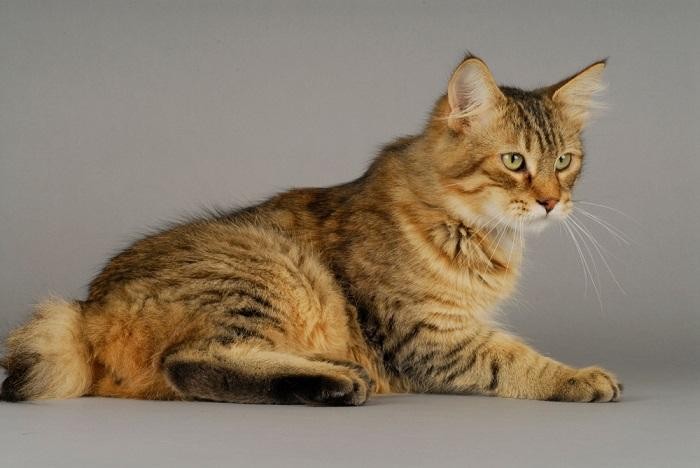
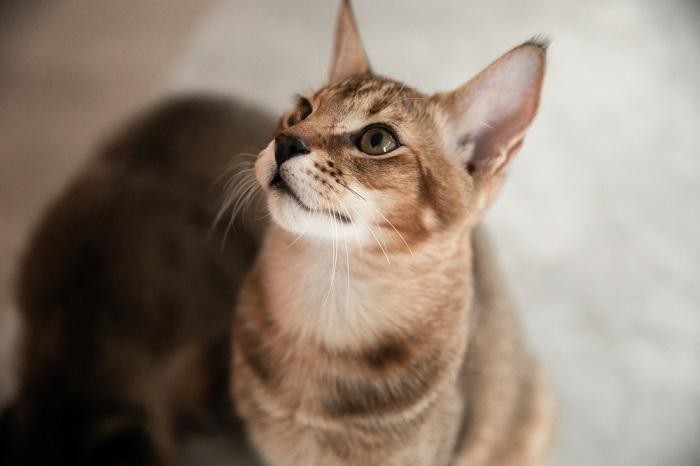
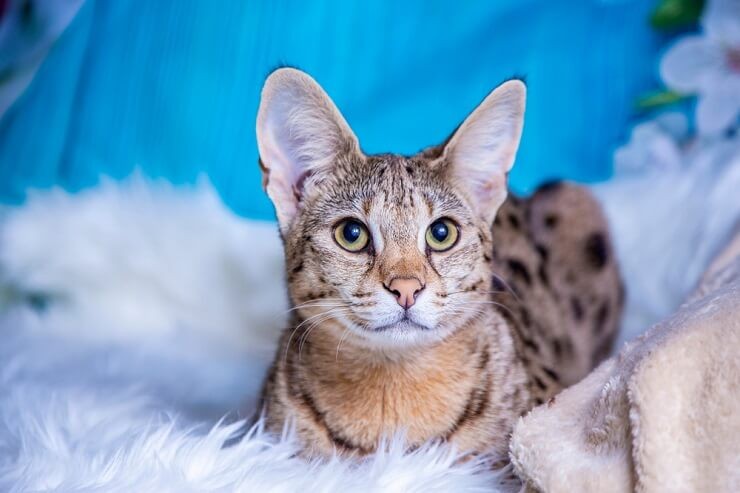
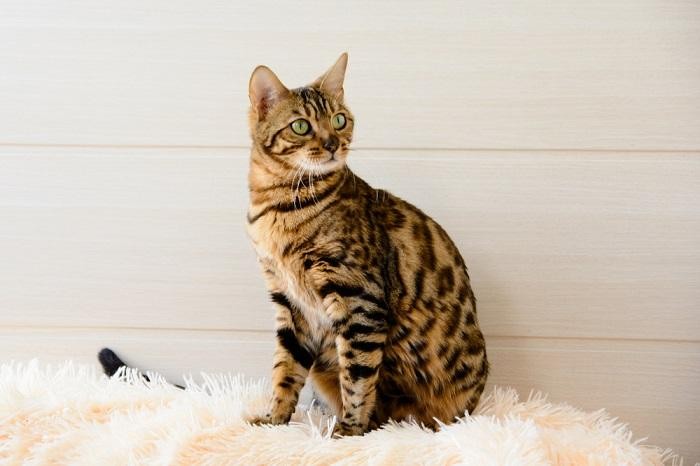
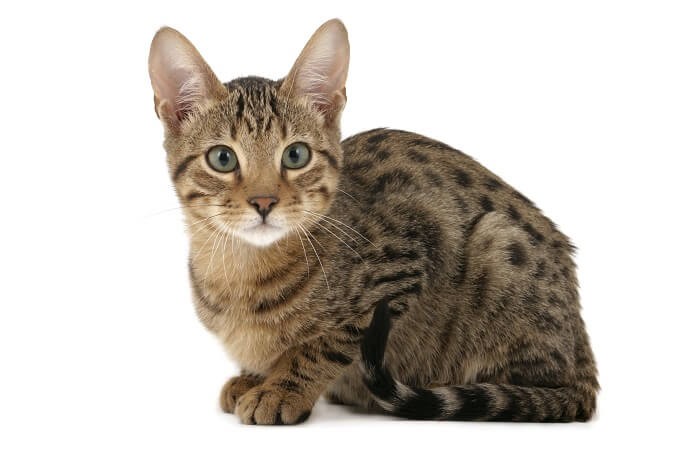
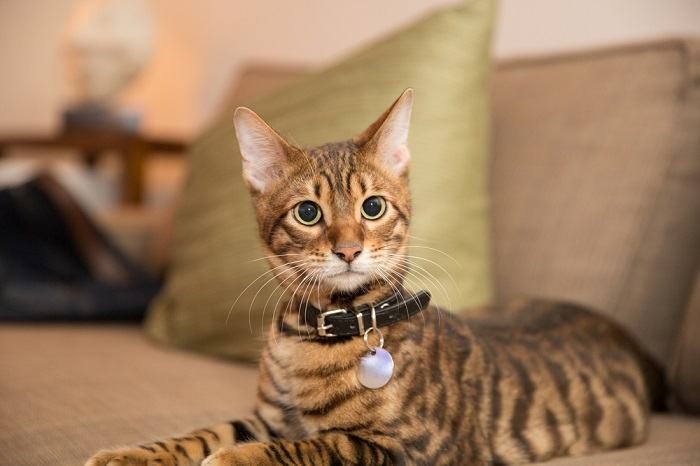
6.4. The Pixie-Bob: A Bobcat Look-Alike
The Pixie-Bob is a domestic cat breed that resembles a bobcat in appearance. Despite claims that the breed was created by crossing a bobcat with a domestic cat, this is untrue. The Pixie-Bob was founded with a large, classic-patterned male cat with a short tail and another domestic female cat. The Pixie-Bob is loving, active, social, and dog-like.
6.5. The Chausie: A Sandy-Colored Beauty
The Chausie is a great choice for people drawn to the caracal’s look. This breed comes in a sandy, reddish-brown or gray fur, which looks a lot like the caracal’s coat. The Chausie is a hybrid breed developed in the 1990s by crossing a jungle cat (Felis chaus) with domestic cats. The Chausie is active, athletic, and sociable.
6.6. The Savannah: A Serval-Inspired Breed
The Savannah is a hybrid breed developed using the African serval and domestic cats. The serval (Leptailurus serval) is a small wild cat native to Africa with a slender body, small head, and large ears. The Savannah is curious, outgoing, and assertive, enjoying playing in water and requiring lots of exercise and mental stimulation.
6.7. The Bengal: A Leopard-Like Companion
The Bengal is another hybrid breed developed by breeding domestic cats with the Asian leopard cat (Prionailurus bengalensis). The Bengal has a beautiful and unique coat pattern, with special spots called rosettes reminiscent of the markings seen on leopards, jaguars, and ocelots. Bengals are energetic, outgoing, curious, and affectionate.
6.8. The Serengeti: A Serval Look-Alike
The Serengeti was developed to look like the wild African serval but contains no serval blood. The breed was created using Bengals and Oriental Shorthairs. The Serengeti is confident, friendly, and active. This talkative breed likes to meow at its people to communicate.
6.9. The Toyger: A Miniature Tiger
The Toyger was developed to look like a tiger in miniature and has very little wild cat blood. The breed was initially created using a domestic cat, a Bengal, and a street cat from India. The Toyger is docile, smart, and very friendly.
7. Expert Insights: Contributions from PETS.EDU.VN
At PETS.EDU.VN, we are committed to providing accurate and reliable information about pet ownership and animal welfare. Our team of experts, including veterinarians, animal behaviorists, and experienced pet owners, contribute to our comprehensive resources.
7.1. Promoting Responsible Pet Ownership
We believe that responsible pet ownership starts with education and understanding. Our articles and guides aim to inform potential pet owners about the unique needs of different animals, empowering them to make informed decisions.
7.2. Advocating for Animal Welfare
We advocate for the well-being of all animals, promoting ethical treatment and responsible care. We encourage our readers to consider the ethical implications of owning exotic animals and to prioritize the animal’s welfare above personal desires.
7.3. Connecting Pet Owners with Reliable Services
PETS.EDU.VN connects pet owners with reliable services, including veterinary care, grooming, training, and pet supplies. Our directory of trusted professionals and businesses helps pet owners find the resources they need to provide the best possible care for their animals.
8. Frequently Asked Questions About Caracals as Pets
Understanding the common concerns and questions surrounding caracal ownership is crucial for making informed decisions.
8.1. Are Caracals Friendly to Humans?
Caracals are wild animals and are not inherently friendly toward humans. In the wild, caracals are solitary animals that prefer to live alone. Even caracal kittens bred to be sold as pets still have wild instincts, including an aversion to humans.
8.2. Is a Caracal Cat Aggressive?
Caracals, even those bred to be sold as pets, retain their wild instincts. They can be aggressive toward humans and other animals like pet cats and dogs. Although caracals raised from kittens might learn to live with humans, these are still wild felines and can be extremely unpredictable, even dangerous. Like housecats, caracals will make sounds that warn of impending aggression, including growls and hisses. Attempting to tame a caracal found in the wild is not recommended by wildlife experts.
8.3. Can a Caracal Hurt You?
Caracals are small, so caracal attacks on humans are rare; however, they do happen occasionally, especially when people keep these exotic animals as pets. Any wild animal, including caracals, can be dangerous if cornered. Caracals are more likely to hurt children and the elderly and can injure or even kill other pets like cats and dogs.
8.4. How Much Does a Caracal Cost?
Breeders raise and sell caracals as pets, and they can cost exorbitant amounts. Wildlife experts strongly warn against keeping caracals as pets, even if it is legal to do so in your state.
9. Ethical Considerations: The Impact on Wildlife Conservation
Owning a caracal can have far-reaching consequences for wildlife conservation efforts.
9.1. The Demand for Wild-Caught Animals
The demand for caracals as pets can fuel the illegal wildlife trade, leading to the capture and removal of animals from their natural habitats. This can disrupt ecosystems and threaten the survival of wild populations.
9.2. The Risk of Introducing Invasive Species
If a pet caracal escapes or is released into the wild, it can become an invasive species, preying on native wildlife and disrupting the balance of ecosystems.
9.3. Supporting Conservation Efforts
By choosing not to own a caracal, you can support wildlife conservation efforts and help protect these animals in their natural habitats. You can also contribute to conservation organizations working to protect caracals and other endangered species.
10. Alternatives to Caracal Ownership: Supporting Conservation and Enjoying Domestic Companions
Instead of owning a caracal, consider alternative ways to appreciate these animals and support their conservation.
10.1. Visiting Zoos and Wildlife Sanctuaries
Visiting accredited zoos and wildlife sanctuaries allows you to observe caracals in a safe and controlled environment. These institutions often contribute to conservation efforts and provide educational opportunities.
10.2. Supporting Conservation Organizations
Donating to or volunteering with conservation organizations dedicated to protecting caracals and their habitats can make a meaningful difference.
10.3. Adopting a Domestic Cat
Adopting a domestic cat from a local shelter or rescue organization provides a loving home for an animal in need while avoiding the ethical and practical challenges of owning a wild animal.
Conclusion: Making Informed Decisions and Prioritizing Animal Welfare
The decision of whether to keep a caracal as a pet is complex and requires careful consideration. While the allure of owning an exotic animal may be strong, it’s crucial to weigh the challenges, ethical implications, and potential consequences for both the animal and the owner. At PETS.EDU.VN, we advocate for responsible pet ownership and prioritize animal welfare. We believe that caracals belong in the wild, where they can thrive in their natural habitat. If you’re drawn to the exotic look of a caracal, we encourage you to explore domestic cat breeds that offer a similar aesthetic appeal while being well-suited for life as companion animals.
Remember, owning a pet is a lifelong commitment that should be based on love, respect, and a deep understanding of the animal’s needs. By making informed decisions and prioritizing animal welfare, we can create a better world for all creatures.
For more information on responsible pet ownership, animal welfare, and exotic animal care, visit PETS.EDU.VN or contact us at 789 Paw Lane, Petville, CA 91234, United States. You can also reach us via Whatsapp at +1 555-987-6543.
At pets.edu.vn, we believe that providing a safe and nurturing environment for our domestic animals ensures a happy life. You’ll find valuable resources and guidance for cat ownership, animal behavior, and the distinct care needed for exotic animals, supporting you in offering the best care while ensuring their well-being. We are dedicated to assisting you in making well-informed decisions that champion the welfare of all animals.